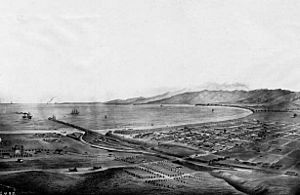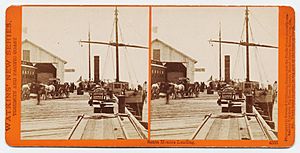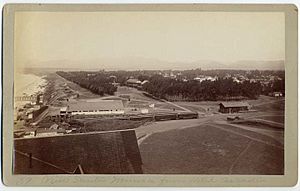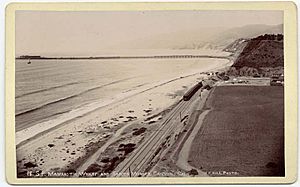Los Angeles and Independence Railroad facts for kids
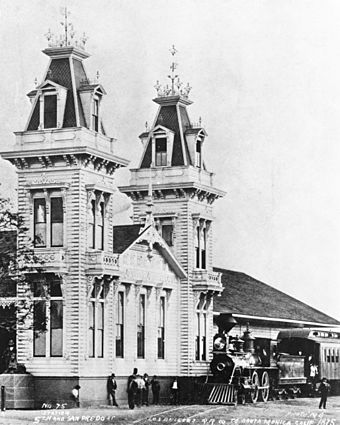 |
|
| Overview | |
|---|---|
| Headquarters | Los Angeles, CA |
| Locale | Santa Monica to Los Angeles |
| Dates of operation | 1875–1877 |
| Predecessor | None |
| Successor | Santa Monica Air Line |
| Technical | |
| Track gauge | 4 ft 8 in (1,422 mm) |
| Length | 16.67 miles (26.83 km) |
The Los Angeles and Independence Railroad was an old train line that used steam engines. It started running on October 17, 1875. This railway connected Santa Monica (near where the pier is today) to downtown Los Angeles.
The company hoped to extend the line all the way to Independence. This was to help transport silver from the Cerro Gordo silver mines. But the railway never went past Los Angeles.
Later, the Southern Pacific Railroad bought the line. Today, the same path is used by the Los Angeles Metro's E Line light rail.
Contents
History of the Railroad
Why a Railroad Was Needed
In the early 1870s, the Cerro Gordo silver mines in Inyo County, California were very busy. They produced a lot of silver. To ship this silver, it went by wagon to Los Angeles. From there, it traveled by train to Wilmington. Finally, it went by ship to San Francisco.
This trade brought a lot of money to Los Angeles. City leaders wanted to make sure this business continued. They thought a new train line to the mining areas would help.
In 1874, the state allowed former governor John G. Downey and businessman F.P.F. Temple to build a railroad. It was planned to go from Los Angeles to Independence. This would make transporting goods much easier.
Important people from Los Angeles and Inyo Counties were on the railroad's board. This included Temple, Downey, and Benjamin D. Wilson. Miners like M.W. Belshaw and Victor Beaudry were also involved.
The Southern Pacific Railroad was worried about this new competition. But the new Los Angeles Area Chamber of Commerce helped get the plan approved.
Planning the Route
In May 1874, Joseph U. Crawford became the chief engineer. His job was to find the best path for the railroad. He needed to find a way through the Cajon Pass to the mining areas.
Crawford surveyed the land and reported back to the directors. At the same time, the directors tried to get local people to invest money. But it was hard to find enough support.
A New Investor Steps In
Crawford's report caught the eye of Nevada Senator John P. Jones. He was a rich miner from the Comstock Lode. Jones owned silver mines in Panamint, also in the Owens Valley.
Jones saw how useful a railroad would be for his silver. In September 1874, he invested $220,000 in the project. This big investment made the railroad much more likely to happen.
In December, Jones and Robert S. Baker joined the railroad's board. Baker owned land near Santa Monica. Soon, people heard that Jones and Baker were working together.
On January 2, 1875, the Los Angeles and Independence Railroad (L.A. & I.) officially formed. Jones became the President. Temple was the Treasurer.
Santa Monica's Role
Two days later, Jones and Baker announced a new plan. They would build a new town by the sea called Santa Monica. Jones had bought a large part of the land for this.
Jones also said they would build a large wharf in Santa Monica. The train tracks would go from Los Angeles to this new town. They would use standard-gauge tracks, not the smaller narrow-gauge ones first planned.
These new plans worried the Southern Pacific Railroad even more. They were building their own line through Los Angeles. This line would connect Los Angeles to their main transcontinental route.
The Southern Pacific tried to stop the L.A. & I. line. But their efforts failed.
The "Battle of the Pass"
Meanwhile, engineer Crawford went to the Cajon Pass. A train route through this pass was key to reaching the mines. There was only space for one railway line. The L.A. & I. had the first right to use it.
The Southern Pacific wanted to survey the pass first to block the L.A. & I. On January 9, 1875, a famous event happened. It was called the "Battle of the Pass." Crawford and 100 Chinese workers arrived first. They started marking out the route. This secured the pass for the L.A. & I.
The workers also began digging a long tunnel in the Cajon Pass area.
Local ranchers gave the L.A. & I. land for the tracks for very little money. They wanted access to the railroad. The city of Los Angeles also granted land for the tracks in July 1875. The Los Angeles station was built at San Pedro Street and Wolfskill (4th street).
Building the Railroad
Construction began on February 24, 1875, in Santa Monica. Workers started building the wharf and grading the land. The wharf was 1740 feet long. It needed to be finished quickly. This was so the company could get rails and other supplies by ship. This way, they would not need to use Southern Pacific's facilities.
Jones traveled east to buy rails and train cars. He even talked to Jay Gould, a railroad owner. Jones suggested extending the line to Utah. This would create a new transcontinental route. It would compete with the Southern Pacific.
Over several months, more money was raised from local towns. This added another $260,000 to the project.
In March 1875, the Southern Pacific finished a line to Caliente. This was near Bakersfield. They also built a wagon road to the silver mines. This allowed the Southern Pacific to get some of the mining freight business. Even so, Los Angeles still had a lot of freight traffic.
By July, the Santa Monica wharf was finished. Train crews started getting building materials. In August, they began laying tracks from Santa Monica.
Challenges and Opening
As construction continued, problems arose. In August 1875, silver mine stock prices crashed. This led to the failure of the Bank of California. It also caused problems for banks in Los Angeles, including Temple's bank. Temple's bank closed in January 1876. These financial troubles meant less money for the railroad.
Because of this, construction east of Los Angeles stopped in September. This included work in Cajon Pass.
A part of the line was tested on October 17, 1875. Passengers rode in carriages to the Cienega stop. Then, they took the train to Santa Monica.
The Los Angeles station was finished on November 27. The full line officially opened on December 1, 1875. It ran only from Santa Monica to Los Angeles.
The L.A. & I. charged $1.00 per ton for freight and $1.00 per passenger trip. The Southern Pacific lowered its rates to compete. This made it hard for the new line to make a profit.
The L.A. & I. also faced other issues. It could only deliver freight to Los Angeles. The Southern Pacific could ship goods to many more places. In 1876, Wilmington still handled twice as much business as Santa Monica.
On September 6, 1876, the Southern Pacific connected Los Angeles to its main transcontinental route. This made the L.A. & I. even less competitive.
Finally, problems at the Cerro Gordo mines and the closing of Jones's Panamint mines in May 1877 caused more trouble. Jones decided to sell the railroad.
He sold the line to the Southern Pacific for $100,000 cash and other payments. On July 4, 1877, the Los Angeles and Independence Railroad became part of the Southern Pacific.
In 1879, the Southern Pacific tore down most of the Santa Monica wharf. This helped them focus all shipping on their Wilmington port. By November 1878, the L.A. & I. was no longer listed separately. It was just part of the Southern Pacific's schedule.
After Southern Pacific Took Over
The Southern Pacific extended the tracks in 1891 to their new Long Wharf. This wharf was north of Santa Monica Canyon. It allowed bigger ships to dock. This made the line important for both freight and passengers.
However, in 1899, the U.S. Government decided to build a breakwater in San Pedro. This created the Port of Los Angeles. This decision meant that natural harbors like Santa Monica would no longer be used for large commercial shipping.
By 1908, the Port of Los Angeles was almost finished. Shipping traffic stopped in Santa Monica. The Southern Pacific leased the railroad line and Santa Monica wharf to the Los Angeles Pacific Railroad. This company was a part of what became Pacific Electric.
That year, the part of the line between the long wharf and Sentous (La Cienega) was electrified. The rest of the line was electrified by 1911. The wharf was torn down in 1913.
Locomotives
| Number | Wheel
Arrangement |
Builder | Builder
Number |
Date Built | SP
Number |
Disposition |
|---|---|---|---|---|---|---|
| 1 | 4-4-0 | Danforth, Cooke & Company | 1004 | 1875 | 1170 | Sold in 1896 to Ventura & Ojai Valley #1 |
| 2 | 4-4-0 | Danforth, Cooke & Company | 1005 | 1875 | 1171 | Sold in 1896 to Ventura & Ojai Valley #2 |
Santa Monica Air Line
By 1920, this train line was known as the Santa Monica Air Line. It was part of the Pacific Electric Railway. It offered electric freight and passenger service between Los Angeles and Santa Monica.
E Line (Los Angeles Metro)
The line was later bought to be used as a light rail line. This new light rail line started running in 2012. It is now known as the E Line.
Legacy
In 2015, a restaurant in Santa Monica was named after the railroad. The Independence offers drinks named after the old train stops. It even held a party for the steam line's 140th anniversary.



